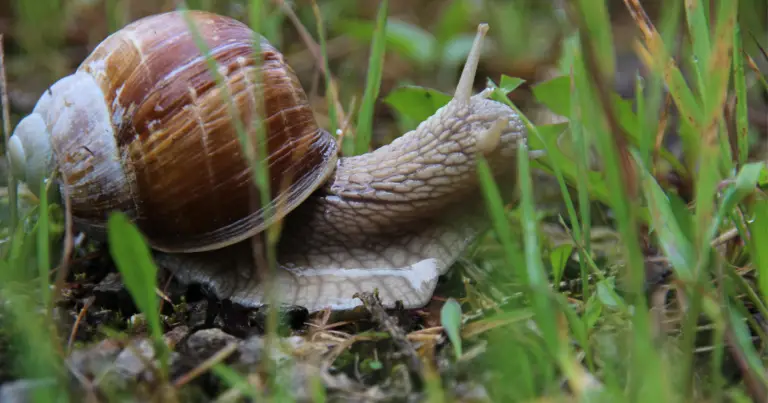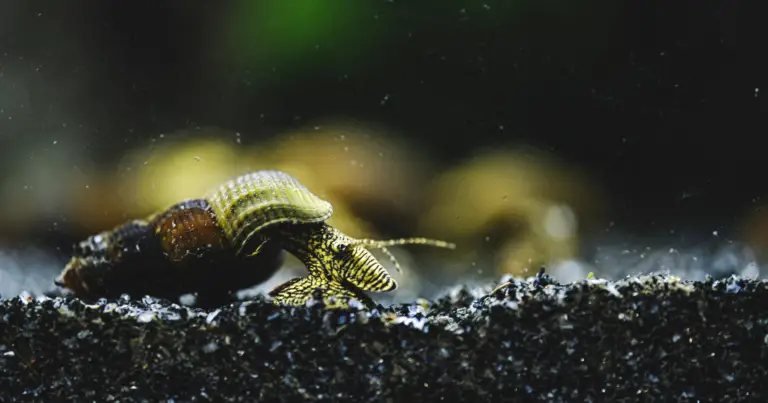Do Snails Eat Grass?

You might wonder, “Do snails eat grass?” especially if you’ve noticed these small creatures in your garden or lawn. While snails are fascinating, their presence can concern those trying to maintain a healthy and attractive outdoor space.

The simple answer is that snails eat grass, primarily in its juvenile stages. As the grass grows older, it incorporates silica, making it difficult for snails to chew and digest. This is why snails tend to consume younger grass seedlings, which are softer and more tender for them to eat. In doing so, snails can potentially cause damage to your lawn or garden, making it crucial for you to take preventative measures to protect these areas from snail infestations.
By understanding the eating habits of snails and their preference for tender grass, you can better address potential issues in your garden or lawn and keep these creatures under control. Keeping your outdoor space healthy and snail-free can be achieved by implementing various strategies, such as creating barriers and maintaining proper moisture levels.
Contents
Table of Contents
What Snails Eat?
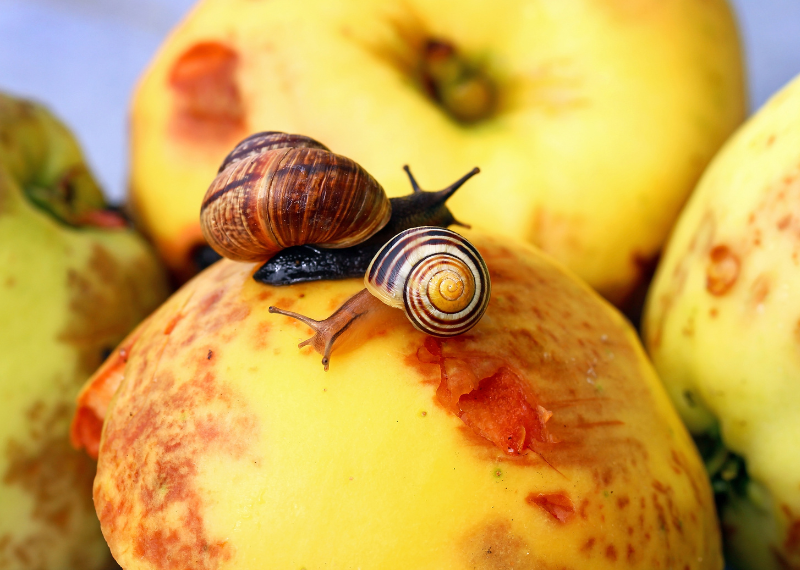
Regarding their diet, snails are primarily herbivorous, which means they eat plant material. They consume various plants, leaves, and vegetables, making them a common sight in gardens and parks. Here’s what you need to know about the typical diet of snails.
Snails are fond of fresh leaves, preferring tender, young growth over older, tougher material. They’ll happily munch on lettuce, herbs, and vegetables such as cucumber, broccoli, and tomatoes. Fruit like apples, strawberries, and grapes are also part of their diet. However, they must be careful not to damage the fruit’s skin as they feed.
Besides fresh plant material, snails also enjoy algae and fungi, which provide essential nutrients.
While snails prefer fresh plants and vegetables, they’re opportunistic feeders and consume other food and plant materials. This includes tree bark, herbaceous plants, and decaying plant material. They’re also known to eat seeds, although they may avoid tougher or poisonous varieties.
Hydration plays a crucial role in a snail’s health and diet. Snails require water to digest their food and facilitate movement. They obtain water primarily from their food but can also absorb it from rainwater or environmental moisture.
When it comes to supplements, snails may need additional sources of calcium to maintain their shells properly. They’ll consume eggshells, lime, or even silica-rich materials such as bran to fulfill their calcium needs. As such, you may notice silvery trails on surfaces where snails have consumed calcium-rich substances.
It’s important to note that snails should avoid processed foods like bread, rice, and crackers. These items lack the necessary nutrients and can harm their digestive systems.
In summary, snails primarily consume plant material, vegetables, fruit, herbs, and other natural food sources. They require water and calcium supplements to maintain their health. Although they’re usually found feasting on plants, snails also adapt their diet according to their environment and available resources, making them versatile and resilient creatures.
Eating Habit of Garden Snails
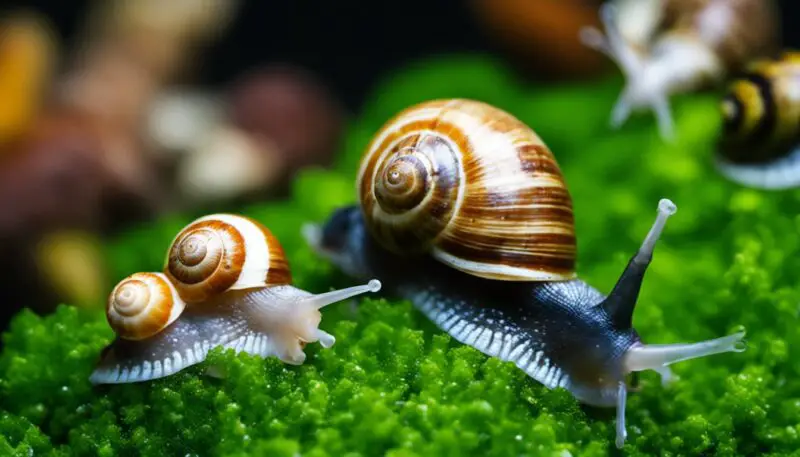
Garden snails have a diverse diet consisting mainly of plant materials such as leaves, stems, flowers, and fruits. While living in your garden, they might munch on grasses, herbs, and vegetables, including your precious flowers and lawn source.
You might notice damage caused by their feeding habits, like small holes in the softer parts of leaves. They tend to eat between the veins, leaving their mark, especially on plants like carnations, dandelions, hibiscus, lilies, and roses source.
Garden snails prefer moist environments as they move around on a mucus trail; a dry and hot day could harm them because mucus could evaporate quickly. To avoid this, they often stay hidden beneath debris, stones, or wood in your backyard during the daytime and become more active at night or early morning hours when the humidity is higher.
Without proper control measures, snails can become a nuisance in your garden. Juvenile snails can even kill grass seedlings, which they view as potential food sources (source). To minimize their impact on your lawn and protect your plants, try creating barriers around the areas you want to keep snail-free. Removing potential hiding spots such as debris, stones, or wood can also help manage their presence in your garden.
Being aware of the eating habits of garden snails, you can plan your garden layout and preventive measures accordingly. Adopting effective strategies to keep the snail population under control will ensure a healthy and vibrant green space for you to enjoy.
The Snail and Grass Relationship
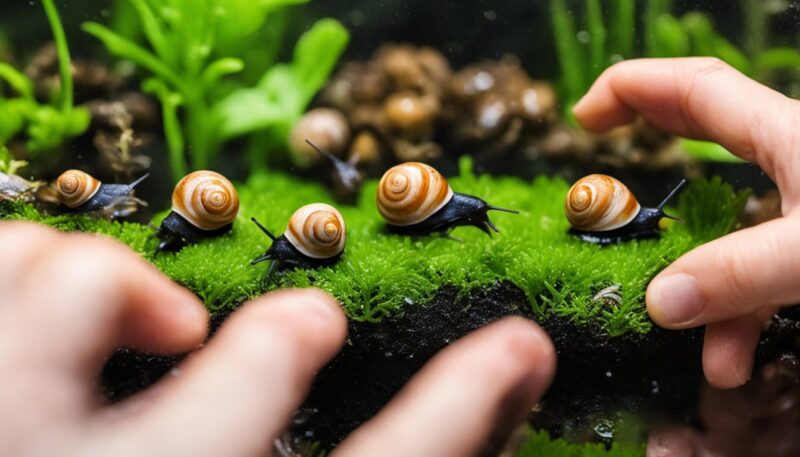
When it comes to snails and grass, their relationship varies depending on the maturity of the grass. Snails are generally attracted to moist and dark areas, often found in lawns. However, depending on their growth stage, different types of grass might be more or less attractive to snails.
For instance, if newly sprouted grass grows in your lawn, it may be more susceptible to snail damage. According to the University of California Integrated Pest Management Program, snails and slugs prefer turfgrass seedlings and herbaceous plants. This means that juvenile snails, in particular, may target grass seedlings as a food source.
On the other hand, established lawns are less likely to be impacted by snails. Snails can even benefit mature lawns by cleaning up dead organic materials and recycling nutrients back into the soil, which helps to nourish the grass and keep it healthy.
It is important to note that snails tend to avoid mature grass due to its higher silica content, which makes it difficult for them to chew and crawl on.
Here are some factors to consider if you want to manage snails in your lawn:
- Lawn Health: Maintain a healthy lawn to deter snails. Proper mowing, fertilizing, and watering will promote strong, mature grass that is less appealing to snails.
- Moisture Control: Snails thrive in damp environments. Make sure to avoid overwatering your lawn and consider improving drainage if necessary.
- Natural Predators: Consider introducing beneficial predators, such as ground beetles or Decollate snails, to help control the snail population in your yard.
Lastly, you must ensure that your snail control methods are pet-friendly if you have pets. Many chemical snail baits can harm pets, so opt for organic or natural alternatives like diatomaceous earth or copper barriers to keep your lawn and your pets safe.
Snails and Other Food Sources

When considering snails and their dietary preferences, it’s important to know that they may consume various items beyond just plants and grass. Some snails also eat other snails, small animals, caterpillars, worms, and even fungi like mushrooms. This diverse range of food sources may surprise you, but it showcases their adaptability in different environments.
In some cases, snails have been observed feeding on paper and ink, demonstrating their ability to gain nutrients from unexpected sources. While this might seem unusual, it highlights the versatility of these gastropods. However, it’s essential to understand each snail species’ specific diet and nutritional needs.
Interestingly, snails are also known to feed on calcium-rich materials, such as soil and leafy green vegetables. This is because their shells require a constant supply of calcium to maintain strength and structure. Moreover, some species of snails, like the common garden snail, may feed on hemp plants, adding to their variety of food sources.
To conclude, snails have a diverse diet ranging from grass and plants to small animals and even fungi. Understanding each species’ preferences and dietary needs is important to ensure their health and maintain a balanced ecosystem in your garden or outdoor spaces.
How to Feed a Snail? Watch this
Impact of Snails Eating Habits on the Ecosystem
Snails play a significant role in their ecosystem, and their eating habits can impact various aspects of their habitat, including the soil, other species, and even the rain cycle.
As a vital part of the food chain, snails primarily consume decaying plant materials and other organic matter in their habitat. They also feed on different vegetation types, including seedlings and freshly sprouted shoots, which contribute to their direct impact on the ecosystem source. Although snails may not specifically target grass, their diverse feeding preferences can still affect plant life.
Additionally, snails greatly influence soil health, which is crucial in breaking down decomposing plant and animal matter. Consuming these materials, they help recycle nutrients such as nitrogen, making them available for other organisms in the ecosystem. Furthermore, their slimy trails ensure better water retention among soil particles.
Environmental conditions influence snail populations, and rain is one such factor that impacts their activities. Moist conditions provided by rainfall allow snails to be more active, as they are less likely to experience dehydration. Elevated humidity levels facilitate the movement of snails, enabling them to forage for food and reproduce.
Biodiversity is critical for maintaining a thriving ecosystem, and snails are essential in preserving a balance among various species. Birds, amphibians, and small mammals all prey on land snails, making their eating habits significant in sustaining populations of these predators. At the same time, snails indirectly control different plant species by consuming them, notably some invasive or undesirable plants.
In summary, the impact of snails’ eating habits on the ecosystem can be observed in their habitat’s health, soil composition, rain cycle, and overall balance among other species. Their unique role highlights the importance of acknowledging and preserving these essential organisms in the complex web of life.
Snails as Pests
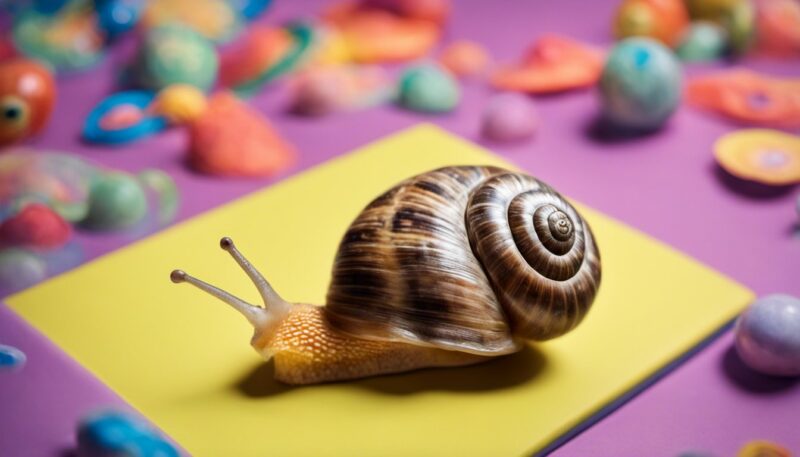
Snails can often be regarded as pests in your garden due to the damage they cause to various plants, flowers, fruits, and vegetables. Juvenile snails, in particular, tend to attack and consume grass seedlings, which can impact the growth and health of your lawn. Their preference for fresh growth on young plants significantly threatens your garden’s health and appearance.
While snails may appear harmless, they can quickly wreak havoc on a well-manicured lawn or garden by feeding on dahlias, delphiniums, clover, hostas, marigolds, and nettle plants. Not only do they consume the leaves of these plants, but they can also cause damage to the flowers, stems, and tubers.
Consider implementing various snail deterrents to protect your garden from snail damage and minimize the disruption they can cause. Some methods for dealing with snails may include creating barriers around susceptible plants, removing excess moisture in the area, and introducing natural predators like birds or frogs that can keep the snail population in check.
When dealing with snails in grassy areas, monitoring for signs of infestation and taking action, if necessary, is important. Snails and slugs prefer turfgrass seedlings and herbaceous plant species, posing a risk to freshly seeded or newly sprouted grass. Keeping an eye out for snail damage in your lawn will help ensure that these pests do not get out of control and cause long-lasting harm to your landscape.
Remember that while snails can be damaging pests in your garden and on your lawn, there are solutions and preventive measures available to help you manage their presence. By addressing the issue early on and staying proactive in your efforts, you can maintain the health and beauty of your landscaping for years to come.
Protecting Your Garden and Lawn from Snails
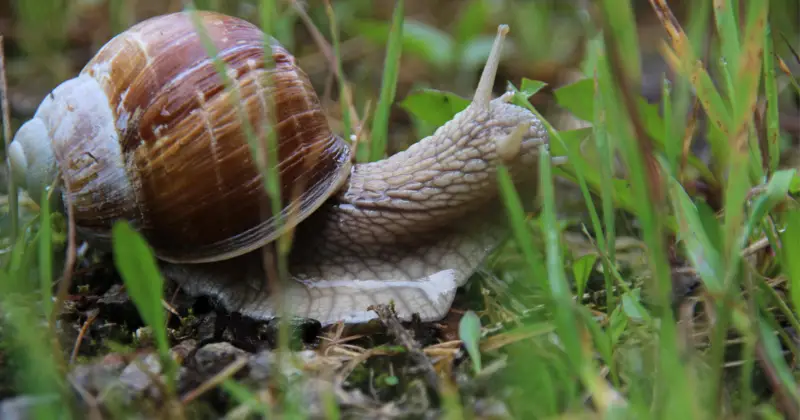
To safeguard your garden and lawn from snails, you can implement several effective methods to mitigate the damage these pests may cause. Snails are known to have a diverse diet that includes various plant materials, but they rarely cause damage to established grass. Nonetheless, taking preventive measures to protect your lawn and garden from snail infestations is essential.
Creating a physical barrier around your garden is one of the best strategies to prevent snails from invading. You can use copper, which acts as a natural repellent due to its reaction when it comes into contact with the snail’s slime. Install a copper band around your garden beds or pots to keep snails away.
Another effective barrier option is diatomaceous earth, a natural and non-toxic powder. Sprinkle this material around your garden, as its sharp particles deter snails and other pests from crossing. Limestone is another natural resource to create a barrier, as snails prefer to avoid contact with it.
Do so with caution when using chemicals or pesticides to control snail populations. Many potent chemicals are harmful to both the environment and beneficial garden creatures. Opt for eco-friendly pesticide alternatives when possible, such as iron phosphate-based pellets. These products are safe for pets and humans, as well as being effective in controlling snail populations.
In conclusion, protecting your garden and lawn from snails involves a combination of physical barriers and careful use of eco-friendly pesticides. With consistent vigilance and preventive measures, you can ensure a healthy, snail-free garden environment.
Snails’ Natural Predators
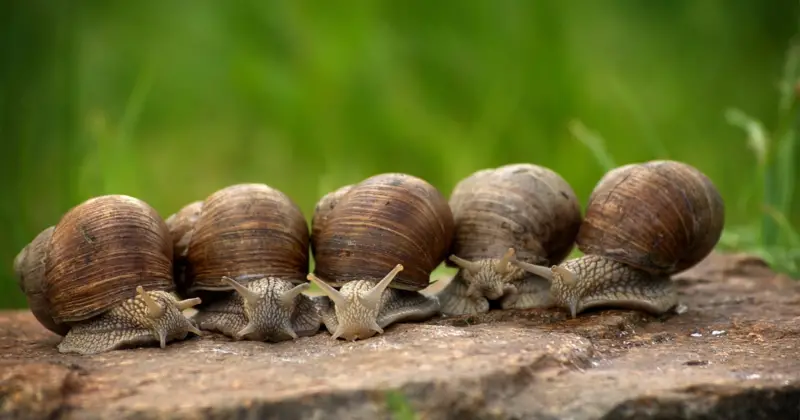
In your garden, various creatures help control the snail population by preying on them. One of the most common predators of snails is birds. These flying creatures can easily spot and capture snails, providing a natural form of pest control.
Among the bird species that prey on snails, blackbirds and wild turkeys are particularly adept at hunting them down. It’s not unusual to see these birds hopping around your grassy areas, pecking away at the snail population. Having these birds in your garden can significantly reduce the number of snails and deter any future infestations.
Aside from birds, other natural predators of snails include mammals such as rats, mice, and weasels. These animals are quick and efficient in capturing snails for a meal. In addition, amphibians like toads and salamanders prey on snails, while reptiles such as turtles find snails a tasty treat.
In the insect world, various species are also known to target snails. Flies, mites, nematodes, millipedes, centipedes, and some caterpillars are among the insects that feed on snails. Even fireflies, beetles, and their larvae contribute to controlling the snail population.
By understanding the natural predators of snails, you can encourage these creatures to inhabit your garden and help control the snail population. Maintaining a balanced ecosystem and providing habitats for these predators will benefit your garden and reduce the need for chemical pest control measures. Remember always to keep a confident, knowledgeable, neutral, and clear tone when sharing this information with others.
Snails’ Life Cycle and Reproduction

The life cycle of a snail starts with the egg stage. Most snails are hermaphrodites, meaning they have both male and female reproductive organs, making it easy for them to reproduce. However, some snail species do exist as separate male and female individuals. As snails mature, they reach sexual maturity between 6 weeks to 5 years, depending on the species you’re studying Snail Life Cycle.
The reproduction process in snails is unique compared to other land animals. When it’s time for them to mate, the female snail lays jelly-like eggs in various locations, such as the water’s surface, on plant stems, or behind rocks Study.com. After laying the eggs, they hatch into baby snails with translucent bodies and soft shells.
During their entire life, snails’ shells expand, requiring calcium in their diet to maintain a healthy shell. Right after hatching, baby snails start eating the leftovers of their egg, and sometimes even unhatched eggs. This provides them with the necessary nutrients to grow and strengthen their shells.
In summary, the snail life cycle is unique and fascinating. From their hermaphroditic attributes to their diverse egg-laying locations, snails are an interesting study subject. Remember that the age at which snails reach sexual maturity varies depending on the species. Their calcium-rich diet is crucial for maintaining a healthy shell throughout their lives.
Keeping Snails as Pets
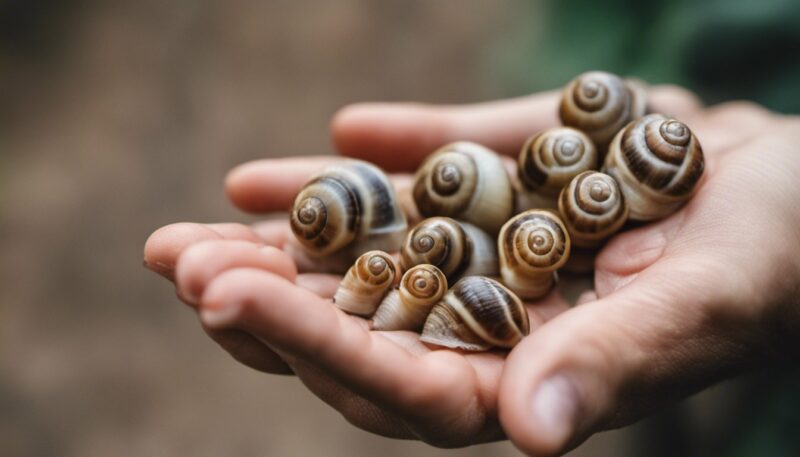
Snails make unique and fascinating pets, especially for those who enjoy observing the natural behaviors of these slow-moving creatures. Before you decide to keep pet snails, it’s essential to understand their specific needs and how to set up their environment.
First, consider that snails are nocturnal or crepuscular creatures, meaning they are most active during dusk and dawn. If you want to observe your snail’s activities during the day and handle it while it’s awake, you might want to adjust your schedule accordingly.
To create a comfortable home for your pet snail, find a suitable container with air holes for proper ventilation. Depending on the size of your snail, you might need a container with a shell size of 1-1 5⁄8 inches in diameter and 1-1 3⁄8 inches high. Your pet snail can live between 2-3 years or even longer with proper care and attention.
When it comes to your snail’s diet, they’re relatively easy to feed. Snails enjoy a diverse diet in the wild and as pets, including plants, fruits, and vegetables such as lettuce, cucumber, kale, and apple slices. You can also offer your snail calcium-rich foods like crushed eggshells or cuttlebone to support the health of its shell.
Knowing potential problems and risks is important while keeping snails as pets. For instance, never releasing pet snails into the wild could cause ecological problems. Snails bred in captivity can potentially carry diseases and parasites that could harm the local snail population and their environment.
Keeping snails as pets can be a rewarding and educational experience, provided you’re prepared to meet their unique needs. Patience, dedication, and observation are key to caring for these fascinating creatures.
Interesting Snail Facts
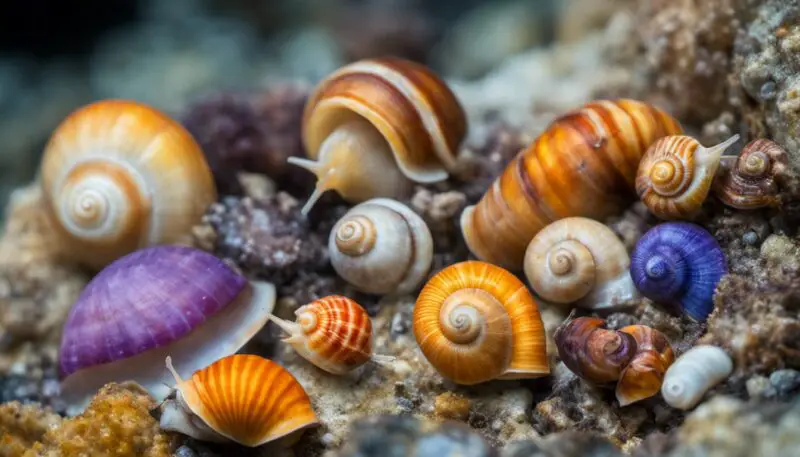
You might be amazed by the diversity and fascinating characteristics of snails. These simple creatures are full of surprises, with an estimated 60,000 species of snails on land and in water.
One of the most striking features of snails is their shell. The shell serves as a protective cover and a home for the snail; interestingly, they are born with their shells. As the snail grows, so does its shell, making it an integral part of the creature’s life. The shell primarily comprises calcium carbonate, which provides a sturdy and secure structure.
Calcium is essential for the snail’s shell and is crucial in maintaining bodily functions. Similar to how humans need minerals to maintain strong bones, snails need calcium to maintain a healthy shell. They obtain this mineral from their diet, including grass, leaves, and other natural materials.
Now, let’s talk about their mouth. A snail’s mouth has thousands of teeth arranged in multiple rows on their tongue-like structure called radula. This enables them to efficiently scrape off food particles from their surroundings, making them efficient eaters.
Another fascinating characteristic of snails is their mucus trail. As they move, they secrete mucus from their foot that helps them to slide along surfaces and avoid sharp objects. This mucus also serves as a protective layer, as it shields the snail from potential harm. The mucus trail can also help snails find their way home if they ever get lost.
So the next time you come across a snail, take a moment to appreciate their unique features and complex life. They may be small, but their fascinating biology and adaptations to the environment can teach us much about the intricate world of nature.
Frequently Asked Questions: Do Snails Eat Grass
What do garden snails consume?
Garden snails primarily eat a variety of plant matter, including leaves, stems, and flowers. They are particularly attracted to freshly seeded or newly sprouted grass, as it’s easier to chew and crawl over (source). As the grass matures, its silica content increases, making it less preferable for snails.
Can snails feed on fruits?
Yes, snails do feed on fruits as well. They often consume the soft and ripe part of fruits, which can cause damage to crops in gardens and farms source.
Do snails eat plants?
Snails eat various plants in gardens, fields, and forests, including flowers, shrubs, and even trees. They enjoy consuming tender leaves, shoots, and stems, which can significantly damage the plants (source).
Which vegetation is preferred by snails?
Snails prefer certain vegetation types, such as soft, tender, and easily accessible plant parts. They typically prefer freshly seeded grass or newly sprouted grass, as these are easier to chew and crawl over (source).
Are snails harmful to gardens?
Yes, snails can harm gardens, as they cause damage to plants by consuming their leaves, stems, and flowers. Their feeding activity can significantly damage crops and decorative plants, making them a nuisance for gardeners and farmers.
What do snails eat in their natural habitat?
Snails consume various plant matter in their natural habitat, such as leaves, stems, flowers, and fruits. Depending on the species, they are also known to feed on decaying organic material, tree bark, and sometimes even fungi.

![Do Snails Eat Grass? [Complete Answer]](https://allourcreatures.com/wp-content/uploads/2021/10/snails-eat-grass-768x519.jpg)
![Do Snail Shells Grow? [Full Guide]](https://allourcreatures.com/wp-content/uploads/2021/11/growing-snail-shells-768x501.jpg)
![Can You Eat Apple Snails? [Read This First!]](https://allourcreatures.com/wp-content/uploads/2021/11/eating-snails-768x514.jpg)
![What Do Zebra Snails Eat? [Full Guide]](https://allourcreatures.com/wp-content/uploads/2021/10/bigstock-Spotted-Nerite-Snail-neritina-402430379.jpg)
